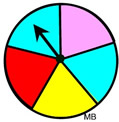|
|
In a uniform probability model, every outcome has an equal probability of occurring. |
|
Consider the example of rolling a fair die.
Rolling such a die is an example of a uniform probability model,
since the probability of any one of the six different number values is always the same.
Uniform Probability Models
|
Event |
Possible Outcomes
(Sample Space) |
Probability |
Rolling a fair die.
 |
There will be 6 outcomes in the sample space, all with the same probability of occurring:
{1, 2, 3, 4, 5, 6}
|
 is probability of each sample space outcome
is probability of each sample space outcome |

Consider the example of spinning a spinner on shades of color.
While the spinner used in this example has been divided into five equal sections,
the colors in each of the sections are not unique.
Two of the sections are the same
shade of blue.
This is a non-uniform probability model, since there is a greater
probability of the spinner landing on blue.
Non-Uniform Probability Model
|
Event |
Possible Outcomes
(Sample Space) |
Probability |
Spinning a spinner.  |
Even though the circle is divided into 5 equal sections, the probabilities are different, based upon color.
|
The probabilities are not all the same, so this spinner is not a uniform model. |

NOTE: The re-posting of materials (in part or whole) from this site to the Internet
is copyright violation
and is not considered "fair use" for educators. Please read the "Terms of Use". |
|